
March 12, 2025 | Articles
Get Stoked: Hill International Makes Big Waves in Spain’s Surfing Scene
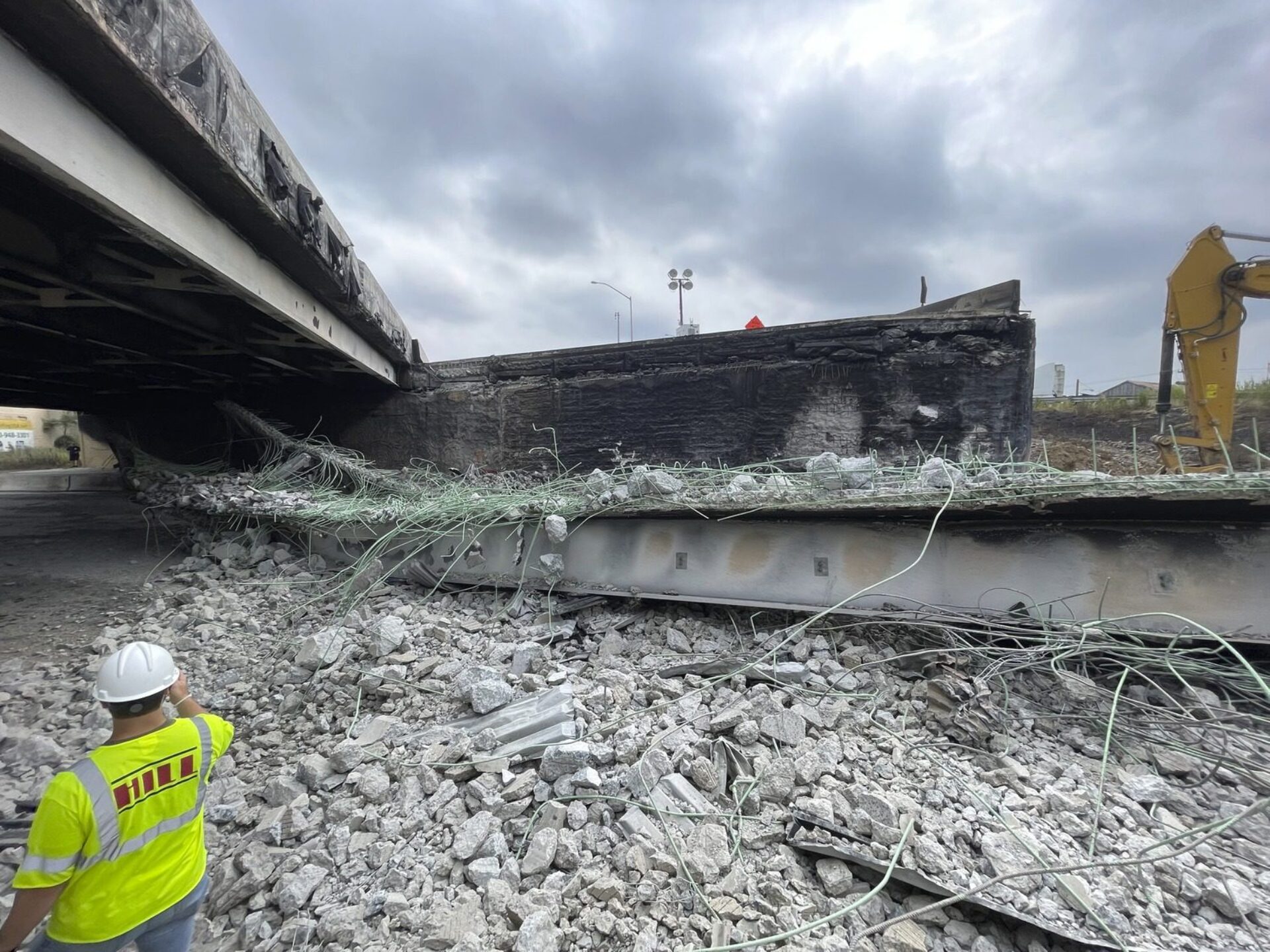
Following a tragic truck accident and gasoline fire that caused the collapse of a segment of Interstate 95 (I-95) in Northeast Philadelphia, the Pennsylvania Department of Transportation (PennDOT) leveraged existing contract vehicles to mobilize active work crews, designers, and consultants to support the emergency repairs. By using personnel already engaged on PennDOT projects, especially those already familiar with the damaged infrastructure, PennDOT saved time by eliminating the need for procurement and opened a temporary solution to motorists in under two weeks.
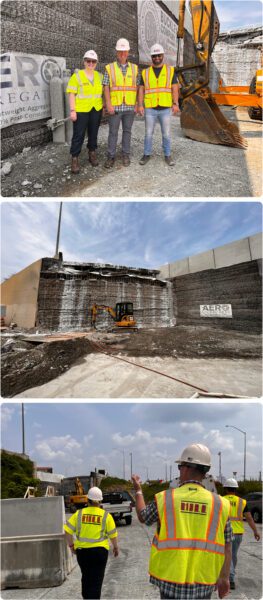
Responding to the Accident
Early on June 11, a tanker truck exiting I-95 via the northbound exit at Cottman Avenue overturned while passing under I-95. A gasoline fire began and quickly spread, sufficiently damaging the northbound bridge structure to cause its collapse. The fire also destabilized the southbound bridge structure such that PennDOT had to shut down I-95 for a mile in both directions. This disrupted both local and regional traffic—approximately 160,000 vehicles, including 13,000 trucks, use the bridge daily. Nathan Moody, the truck driver and a father of three, died in the accident.
As firefighters continued to battle the blaze, PennDOT began working with the Federal Highway Administration (FHWA); the Bureau of Alcohol, Tobacco, Firearms, and Explosives (ATF); the National Transportation Safety Board (NTSB); and other responding parties to investigate the cause of the fire and assess the damage. After Pennsylvania Governor Josh Shapiro declared the collapse an emergency, the Federal Emergency Management Agency (FEMA) pledged to pay for the entire repair project.
With the costs of the repair covered, PennDOT prioritized reopening the highway as quickly as possible. To do so, they engaged team members working on ongoing PennDOT projects in the vicinity of the accident, including the third phase of the Cottman-Princeton Interchange project (CPR), just off the Cottman Avenue exit, and the Betsy Ross Bridge through Bridge Street project (BSR-BRI), a mile to the south.
PennDOT immediately requested that the general contractor working on the adjacent CPR project demolish and clean up the damaged structure. With crews and demolition equipment already in place, C. Abbonizio Contractors from Sewell, NJ, commenced demolition activities on the bridge structure and finished in just four days. This facilitated the investigations into the cause of the accident and the extent of the damage to the bridge structure.
From the start, PennDOT also engaged the CPR project’s designer, Alfred Benesch, and construction manager, Hill International, to begin the process of restoring the roadway. Hill has managed the ongoing reconstruction of the interstate through Philadelphia since 1999. This included the second phase of the CPR project (CP2), which involved the original construction of the Cottman Avenue bridge and exit from 2012 to 2017.
“In the days after the accident, there were still a lot of unknowns,” says Matthew Galbraith, PE, a Hill project manager with more than 20 years of experience supporting highway and bridge infrastructure projects for PennDOT and other state DOTs. “To help with the demo and the investigations, Hill pulled all the design specs for the original bridge from our document control system—all the plans, shop drawings, as-built documents, and other relevant documentation from CP2—and we got those materials to PennDOT that day.”
With CP2 documentation in hand, PennDOT could better assess the extent of the damage to the bridge and the causes of structural failure and begin planning a reconstruction project. However, with the most optimistic estimates for bridge reconstruction indicating a 2024 opening, the project team still needed an interim solution.
Implementing a New, Lightweight Solution
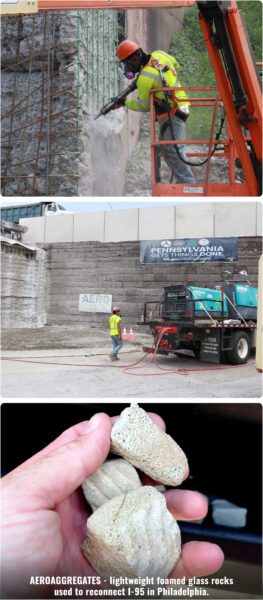
After several rapid planning sessions, PennDOT, Hill, Alfred Benesch, and other stakeholders decided to fill the gap between the elevated sections of I-95 and pave a temporary roadway as quickly as possible. To reduce the weight of the fill without adversely impacting the existing infrastructure under the ramp, the team opted to use a foamed glass aggregate material supplied by AeroAggregates of North America, based in Delaware County, PA.
“We’ve used this lightweight aggregate with PennDOT before,” says Matt. “In fact, our prior usage of AeroAggregates’ material on the adjacent CPR project, represented one of the first implementations of foamed glass aggregate for highway construction in America. It’s excellent for keeping embankments and other aggregate structures light. In this case, there are sewage lines running under Cottman Avenue beneath I-95. To prevent crushing damage to those, we needed a lightweight solution.”
Given the proximity of AeroAggregates to the project site and the established relationship the project team has with the company, PennDOT could quickly procure 8,000 cubic yards of lightweight aggregate. PennDOT mobilized Buckley & Co., a contractor working a little over a mile to the south on a BSR-BRI ramp improvement project, to lead the reconstruction of the destroyed bridge—both the temporary solution and the long-term rebuild. With around-the-clock shifts, Buckley’s team secured the aggregate and installed a new asphalt roadway, along with new signage, striping, and self-supporting, L-shaped shoulders, in only twelve days.
“I think the advantage of foamed glass aggregate is something PennDOT and other State DOTs will be able to take away from all this,” adds Matt. “While it’s more expensive than traditional aggregate, the stability you get for its weight is incomparable. It’s also easy to work and has a variety of uses for road and highway infrastructure. Despite some rain, Buckley’s team was able to get the job done and allow PennDOT to open I-95 back up in under two weeks.”
Paving a Path to Normalcy
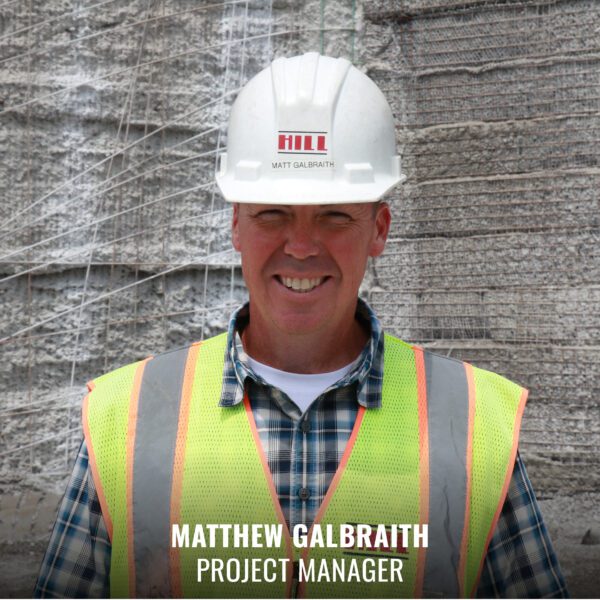
By mobilizing work crews already under contract, executing rapid planning, and quickly implementing a lightweight foamed glass aggregate solution, PennDOT reopened an arterial highway route of national importance much faster than anyone expected. Now, the project team will leverage what they already know about the original bridge’s construction to execute the long-term rebuild efficiently.
“What happened is a tragedy,” says Matt. “And no matter how well the rebuild goes, that’s not going to change. Three kids lost their father. We also know that no matter how quickly we work, the businesses around Cottman Avenue are going to face difficulties as long as the Cottman Avenue exit remains closed. However, PennDOT and the whole project team have done their best given the circumstances, and we’re going to carry on doing whatever it takes to get the emergency repair done efficiently and restore a sense of normalcy to this Northeast Philadelphia community.”
The emergency rebuild is expected to conclude in 2024. For more information about the project, reach out to Matthew Galbraith at [email protected].
Share

March 12, 2025 | Articles
Get Stoked: Hill International Makes Big Waves in Spain’s Surfing Scene

March 9, 2025 | Articles
Project Manager TJ Pinales: Helping Along the Road in San Antonio

March 4, 2025 | Articles
Balancing the Equation: An Interview with Project Manager Tracy Wiyrick

March 1, 2025 | Articles
A Lifelong Project: Calypso Kyriakopoulou’s Multifaceted Career in Construction

February 10, 2025 | Articles
Dual Delivery: A Viable Strategy for Complex Transit Projects

January 23, 2025 | Articles
Plotting a Roadmap to Success on the Torres de Colón Renovation
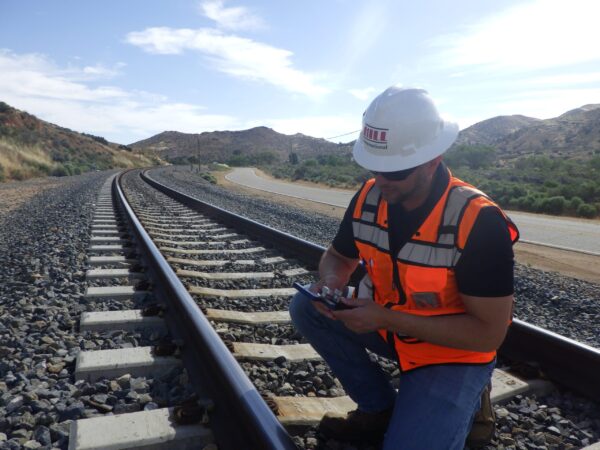
December 12, 2024 | Articles
Progressive Design-Build for Rail and Transit Projects: Room to Run

December 9, 2024 | Articles
Unlocking Growth: Maximizing the Benefits of the SBA’s Mentor-Protégé Program

December 8, 2024 | Articles
Mediterranean Luxury a Century in the Making: Four Seasons Resort Mallorca at Formentor